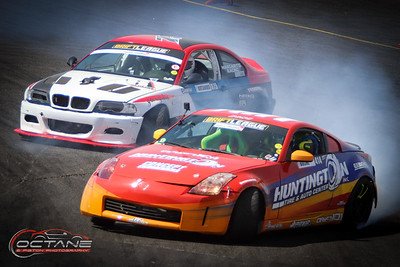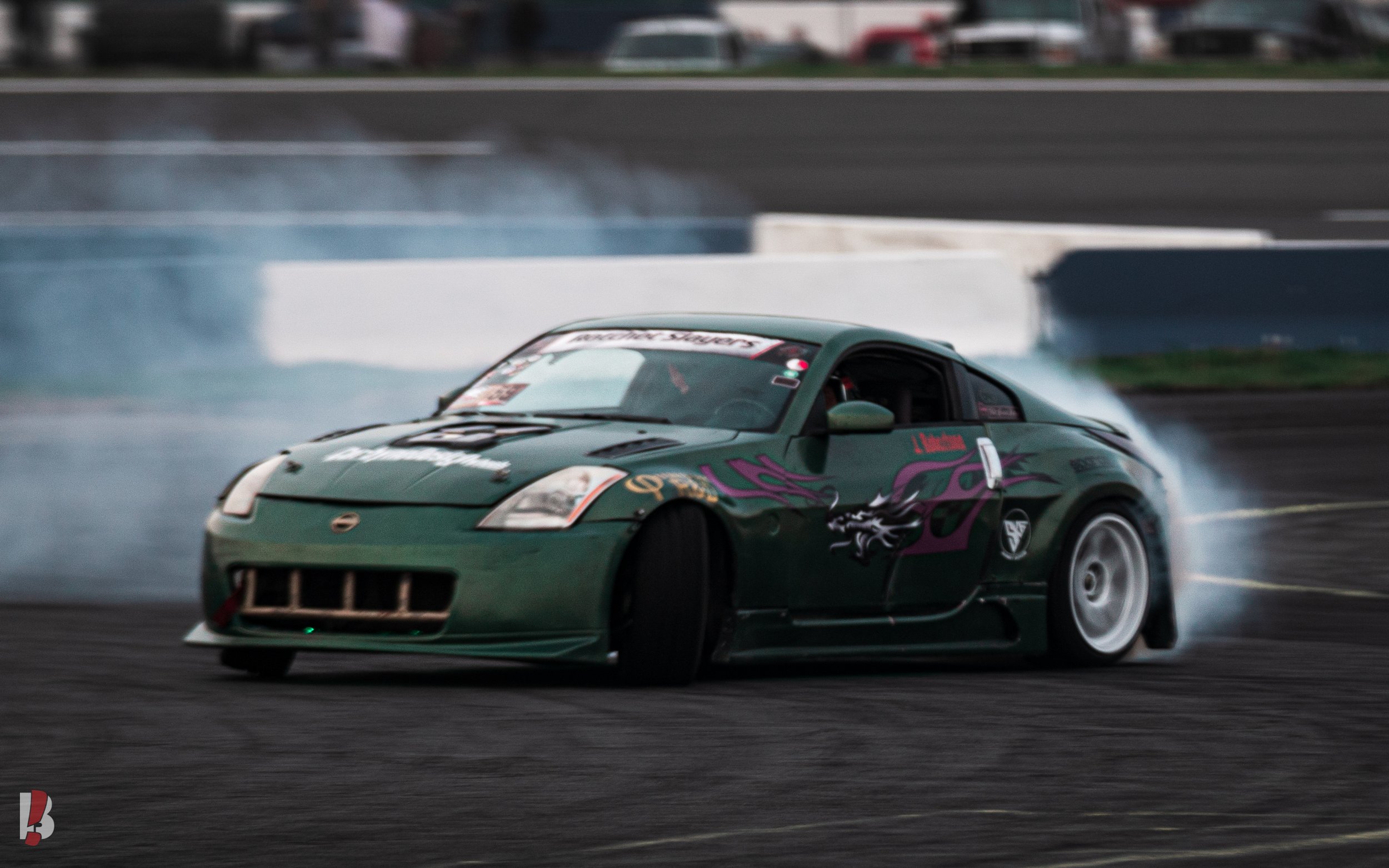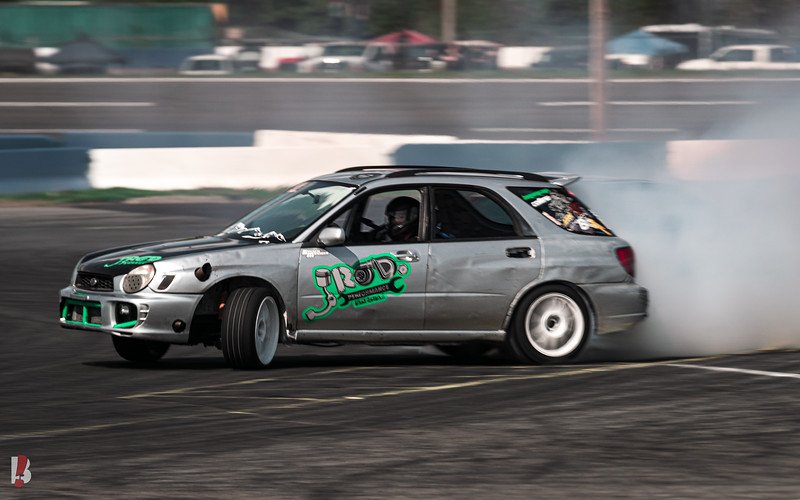FAN TRACKS: YOUR GUIDE TO COMPETITIVE DRIFTING
Photo courtesy of Octane & Piston Photography.
Part 1: Laying Down The Basics.
What Makes Drifting Different?
All motorsports, including competitive drifting, have a set rulebook to regulate areas such as safety, fairness, cheating, exhibition, efficiency, and everything else needing precise clarity, both on and off the track. However, in the case of drifting, the unique rule set is one big thing that makes it a very different competitive motorsport.
Photo courtesy of Christian Buenaventura
Drivers of drift cars are judged on aspects related to form and skill; as opposed to how long it takes them to complete a run. Therefore, the drifting rulebook covers other areas of evaluation, such as unique car and build attributes, driving and safety techniques, and track orientation, to name only a few.
And, while this makes for a super cool differentiator for the sport, it also creates a steep learning curve for the audience. This is especially true for first-time fans who aren’t yet up-to-speed with how competitive drifting works. Even seasoned drifting fans occasionally find themselves second-guessing their knowledge and contemplating ‘what just happened’ on the track.
In fact, the fundamentals of drifting are complicated enough, even long-time professional drivers like Vaughn Gittin Jr. (see Until We Meet Again) say they’d love to see more ways for fans to get a better understanding of how competitive drifting works.
In an effort to help, Drift Enthusiast Magazine is kicking off our first “Fan Track” article covering drifting principles. We want to help you (and your first-time drifting friends) grasp what goes on during all those qualifying runs, tandem battles, and even the competitive drift trains.
This article (the first of an eventual series) gives a high-level overview of what each driver is working to ‘get right’ during a competitive event. It’s just enough to give any first-timer context on what’s happening out there (besides all the pops, screeches, and smoke!)
Photo courtesy of Larry Chen.
It All Starts With A Great Start.
Drift Car Inspections
There are a lot of ‘starts’ to know about in competitive drifting, but understanding a few of the really important ones upfront, will help you immensely.
First, every car must meet inspection guidelines to be able to compete on track. While this is pretty straightforward, the rules that govern body parts, engines, and builds can be fairly complicated and vary from circuit to circuit. If you’re a gearhead, you may want to research this further. And, lucky for you, most of these guidelines are publicly accessible online. Everyone else just needs to know every drift car has to pass muster to drift competitively..
Next comes ‘initiation’. Initiation is the term used for the moment when a driver steers their car into a controlled drift or skid. It’s also an action the judges watch closely, because the timing, finesse, and angle of an initiation pretty much impacts a driver’s entire run. This is true in both solo and tandem runs, so one of the first skills every drift car driver needs to learn is how to initiate a drift as smoothly and expertly as they can.
Photo courtesy of Larry Chen.
Qualifying.
Another important starting factor in drifting is ‘qualifying’. Qualification rules and procedures can also vary greatly from league to league, and they are occasionally adjusted. For example, Formula DRIFT North America recently overhauled their qualifying process, implementing a ‘seeding bracket’ competition that both precedes their main competition rounds and provides a hierarchical method for identifying which drivers will progress into the Top 32 round.
Stay tuned for a subsequent Fan Tracks article covering the new FD seeding bracket in more detail, but for now, we’ll share how qualifying works for most of the other competitive circuits.
First, every driver is required to have a qualifying solo run prior to competing. In most cases, if a driver cannot complete at least one qualifying run, the judges won’t allow the car/driver to proceed into the battle phase of a competition.
These qualifying runs are often scored, and the judges use these scores to determine if (and where) a driver places in the competitive lineup. This makes a good qualifying run exceptionally important for a driver, because it’s possible to be knocked out of an event even before it starts. This is especially true when there are more drivers than open slots in the competition.
Lead drivers in tandem battles are also striving to put down a ‘qualifying’ run each time they compete, and according to former Formula DRIFT judge Ryan Lanteigne, the goal for any lead driver is to score as close to a 100-point qualifying run as possible, every time.
This is why many grassroots drivers with aspirations to go pro tend to focus first on mastering lead run skills that will earn high qualifying scores.
During a recent ride along with Jared Bradfield at Evergreen Speedway, we asked what he’s thinking about when competing in the lead position. “When I’m doing a lead run, I basically tune out the chase driver, because they have their own job,” the up-and-coming grassroots drifter and owner of J-Rod’s Garage in Mount Vernon, Wash. said, “I stay focused on my own lines and angles; not where the other driver is.”
Photo courtesy of Christian Buenaventura.
In short, qualifying is clearly an important concept in drifting all around. And though the term tends to get used more loosely than some others, the best thing for a fan to remember is ‘qualifying’ is never bad in any drifting context.
The Start Line.
The other critical start occurs at the beginning of each tandem run. Like other motorsports, there’s a light tree at the beginning of the drift course to queue drivers when it’s time to put down the hammer.
When all three lights in the tree extinguish at once, the lead driver is free to cross the start line. If the lead driver jumps the line, a restart is called. However, the chase driver can cross the line before all the lights are out, which gives them a fair chance to initiate into drift at the same time the lead driver does. This is especially important when a lead car has the advantage of higher horsepower and/or better grip.
Photo courtesy of Larry Chen.
In pro drifting, a man-made chicane marks the beginning of the course to provide even more assurance of a staggered start. This serpentine-shaped curve (generally made with traffic cones) slows down the lead driver to guarantee a side-by-side drift initiation can happen. In this case, the chase driver is still allowed to leave the line prior to all the lights extinguishing.
With a chicane, if either driver mistakenly taps a cone on the way by/through the curve, the judges will call a restart. In pro, this rule extends to three-strikes you’re out; meaning, if you’ve caused a restart three times, your run is considered incomplete.
Photo courtesy of SuiSlide Girls.
Battling For The Prize.
In every motorsport, it’s the drivers fighting to win that makes the fans sit at the edge of their seats in anticipation. Drifting challenges - or tandem battles - happen between two drivers at a time (unless it’s OG Japanese-style drifting).
Each battle consists of two runs, with the drivers swapping positions on the second time around the course. One driver always has the lead position and the other driver is considered the chase driver (also called the follow driver).
Judges are used to evaluate the skill and accuracy of both drivers in each position, and as we mentioned earlier, the lead driver is always aiming for a 100-point qualifying run. The follow driver is more focused on mimicking the lead driver’s lines and angles, and keeping close proximity to them. This is where everything gets tricky, because literally anything can happen, and the judges must rule accordingly.
For now, we’ll keep it simple. The goal for the judges is to determine which driver did a better job in both the lead and follow runs. Then they decide which driver took the fight overall. However, it’s important to remember, lead runs and follow runs are not scored together. One lead run is compared to the other lead run, and follow runs work the same way.
Of course, there are MANY aspects to how this scoring happens. Far too many to cover in one article, so here’s a snapshot. We’ll cover each area more deeply in future parts of the series.
Image courtesy of Formula DRIFT.
The Drift Track
As we’ve covered in a previous article (see Drift Tracking), some drift tracks are famous for their course layouts and skill requirements. However, it’s common for drifting courses to be continually upgraded by track officials for various reasons (i.e. to increase challenge, create additional obstacles, and/or minimize safety risks and difficulty).
Regardless of how often a course gets changed, each drift track uses a common set of markers to measure skill and distance. Once an onlooker understands what each of these markers mean, they will better understand the sport and what is happening on track.
In short, each track is marked with a strategic combination of zones, walls, and clips. These usually (but not always) are placed on or near where the track curves. The shorter (or innermost) area of the curve is considered the ‘inside’, while the longer (or outermost) area of the curve is known as the ‘outside’.
The track layout is defined by painted lines marking the outside of the driving lane. Competitive drifting layouts may differ from standard racetrack layouts, and often, only a designated section of the bigger track is utilized. Interlocking concrete walls or plastic barriers may be used to define the outside areas of a track, but some tracks only have large tires as bumpers, or back up to open fields or lots.
Clipping Zones are marked by rectangular boxes painted inside the lane. They often have pilons (also called clips) marking the far corners. A driver is expected to steer the vehicle ‘through’ the middle, and up to the far edge, of these zones. Grazing a wall or clip is acceptable, as long as the car stays inside the zone. These track areas also often get referred to as ‘outside’ or ‘outer’ zones by event announcers and may have a chronological number associated with them (e.g. outer zone one).
Clipping Points are marked by a single pylon strategically placed at the apex (inside center point) of designated curves. They are often referred to as ‘inner’ or ‘inside’ clips. On the lane side of the pylon, parallel painted lines (usually three) provide the judge a grid for measuring how close the nose of the car is to the pylon. Grazing the clip earns a driver maximum points, then less and less with each line.
A Touch-and-Go is a point on the outside or inside of designated curves where a driver ideally taps (or seemingly taps) the line or wall, then takes the car immediately into the next drift transition.
Judging Drift Runs.
In many professional circuits, three judges are used for competitive drifting. At the end of a run, each judge ranks the skill of the driver(s) in the focus areas such as skill, line, angle, proximity, style, and more. The combination of all the judge scores are then added together.
Photo courtesy of David Karey.
Drifting Line
According to journalist Andrew Beckford’s March 2018 article published in Motor Trend magazine, “The line judge measures each driver's line performance by observing a driver's proximity to clipping points and zones. They want the drivers to get as close as possible without contact to the clipping points with the front of their cars, and as close as possible without contact to the clipping zones with the rear of their car.”
Photo courtesy of Christian Buenaventura.
Drifting Angle
The driver needs to maintain as high of an angle as possible, while keeping the car’s momentum up and not spinning. As Beckford explains in his article, judges are watching, “the slip angle of each car relative to its direction of travel in outside clipping zones, inside clipping points, and 'touch and go' areas."
Photo courtesy of Larry Chen.
Drifting Style
Style is a little more complicated and refers to the vehicle’s overall behavior from the beginning of the course to the end. From a judging perspective, style breaks into two areas, ‘fluidity’ and ‘commitment’.
When looking at fluidity, the judge will be assessing how long it takes for the driver to achieve angle, how smooth the transition into the angle is, and whether the angle is adequate. Characteristics like slow rotations, stuttered steering, and a lack of angle consistency are usually penalized.
Commitment is all about the vehicle’s forward momentum and the driver’s confidence in maintaining movement when outside the deceleration zones. Lower scores are given to drivers that aren’t on full throttle before initiation, have late initiations, slow down outside decel zones, and show timidness when coming up to walls and outside course lines.
Other Key Things To Know About Competitive Drifting.
Photo courtesy of David Karey.
Drifting Vehicle Proximity
If you’re a motorsport nut, you’ve surely heard the old phrase, ‘rubbing is racing’.
In tandem drifting, rubbing is definitely a thing! And, although it’s a fun thing for the audience to watch, it can be risky for a driver.
While the lead driver stays focused on everything else but the guy chasing him, the follow driver does the opposite. To get the best score, a chase driver has to try to maintain the same angles and lines the lead driver is putting down. To do this with precision, the chase driver is required to maintain uber-close proximity throughout the course, and strive to stay in an area called ‘the pocket’ without causing a problem.
As a result, rubbing, touching, and tapping tend to be typical in competitive drifting, but not always without incident. Therefore, the rules indicate any contact made by the follow driver that causes the lead driver to incomplete will be deemed the fault of the chase driver. This topic is often discussed during the mandatory driver’s meetings that occur prior to competitions, because ‘causing a driver to incomplete’ is often a very gray area when it comes to judging.
Alternatively, when a lead driver makes a mistake that forces a follow driver to incomplete, fault is placed on them. This can be as subtle as not having enough acceleration through a decel zone, which causes the follow driver’s momentum or ability to steer through the drift to falter.
Photo courtesy of David Karey.
The Final Drift
One other good-to-know master rule in competitive drifting has to do with the end of each run. Every driver/car must maintain (and be in control of) the drift as they cross the finish line. If a car isn’t “drifting” across the line, the run is considered incomplete.
We know this is a lot of information to take in, but we also know how helpful it will be the next time (or the first time) you put it to practice. If you can’t get to a track right away, the Formula DRIFT YouTube channel is a good place to test your retention.
Meantime, keep an eye out for more Fan Tracks we will be publishing and including in the Drift Enthusiast Guide To Competitive Drifting, and don’t forget to give us a shout out on Instagram (and every other social platform at @driftenthusiastmag).













